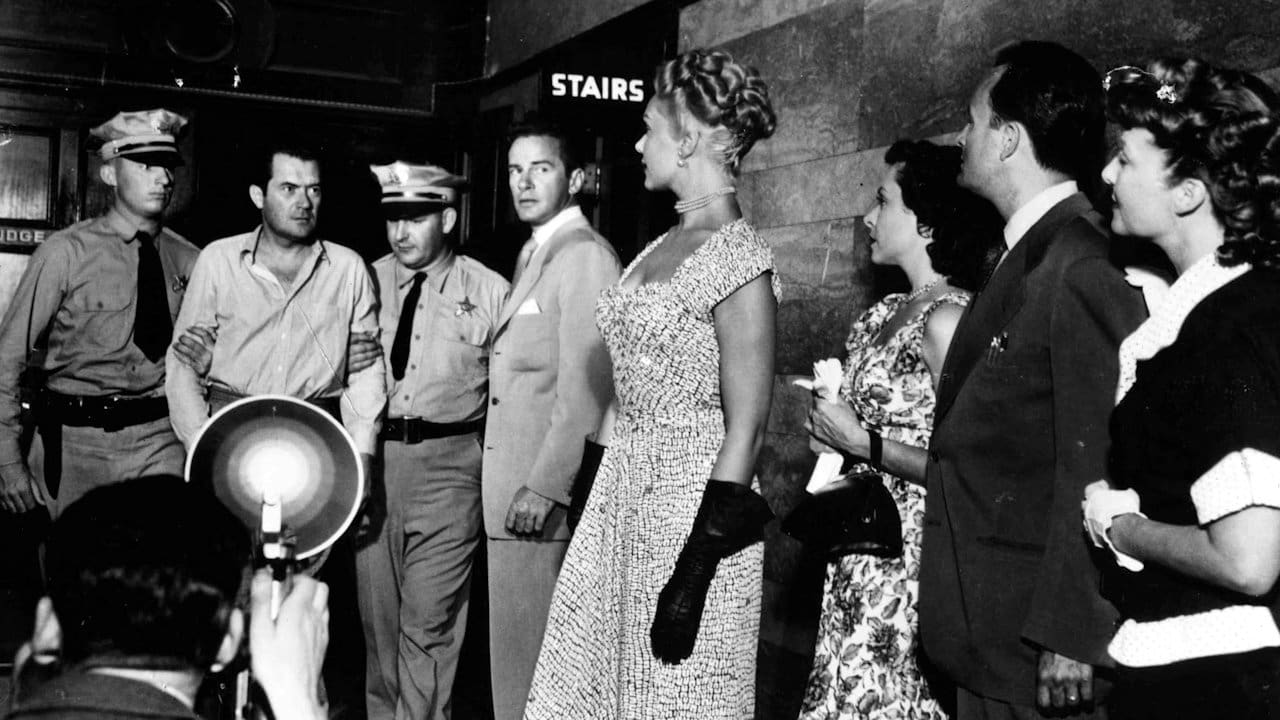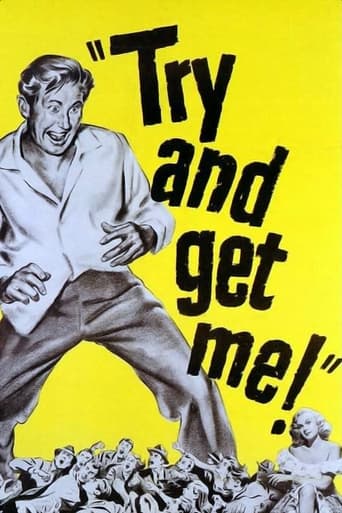Brendon Jones
It’s fine. It's literally the definition of a fine movie. You’ve seen it before, you know every beat and outcome before the characters even do. Only question is how much escapism you’re looking for.
Keira Brennan
The movie is made so realistic it has a lot of that WoW feeling at the right moments and never tooo over the top. the suspense is done so well and the emotion is felt. Very well put together with the music and all.
Sarita Rafferty
There are moments that feel comical, some horrific, and some downright inspiring but the tonal shifts hardly matter as the end results come to a film that's perfect for this time.
Bob
This is one of the best movies I’ve seen in a very long time. You have to go and see this on the big screen.
Claudio Carvalho
The unemployed Howard Tyler (Frank Lovejoy) is desperate for a job since he is married with children and his wife Judy (Kathleen Ryan) is pregnant. When he meets the "bon vivant" Jerry Slocum (Lloyd Bridges), the stranger offers a job position to Howard. Soon he learns that Jerry is a small-time thief and his job would be to drive the getaway car after the heist. Howard improves the life of his family and tells that he is working in the night shift of a factory. Meanwhile, the journalist Gil Stanton (Richard Carlson) that works in a tabloid is assigned by the owner to promote the thefts to increase the selling of newspaper. When Jerry kidnaps the son of a millionaire, he brutally kills the man and forces Howard to help him to dump the corpse in the sea. Then he asks for ransom to the family. When the boy is found, Stanton incites the population telling that the abductors are monsters. When Howard and Jerry are arrested, a mob threatens their lives in front of the police station. How will the police officers protect the prisoners?"The Sound of Fury" is a film with a simple storyline and an impressive conclusion. The manipulation of the masses by the "brown press" (tabloid) to sell newspapers is impressive and the consequence is scary. The reaction of the uncontrollable violent mob is the best part of this movie and shows the power of the free press, for the good or for the bad. My vote is seven.Title (Brazil): "Justiça Injusta ("Justice Unjust")
Terence McArdle
A harrowing indictment of lynch mob violence, The Sound of Fury (AKA Try and Get Me) pulls no punches. Out of work family man Frank Lovejoy gets involved in small time stick-ups with sociopath narcissist, Lloyd Bridges (yes, the Sea Diver star). Eventually, they progress to kidnapping. Bridges' true character comes out and leads to murder. Lovejoy's family man breaks down, drinks heavily and confesses his duplicity to a woman he has picked up. She goes to the police and the two are arrested. A local scandal sheet starts whipping the community into a frenzy, an announcer actually calls for a lynching on the radio and soon a mob takes out Lovejoy and Bridges as they await trial. That's it -- and that last scene is absolutely terrifying. This was a courageous movie to make at the height of the McCarthy era (1950). The story was inspired by a 1933 lynching in San Jose of two kidnapping suspects; a murder by mob that was actually condoned by then Calif. Gov. James Rolph. The movie conveys a real ambiance of poverty and grittiness beyond the typical film noir posturings of the era. Lovejoy and Bridges are at their best. The Lovejoy character is sympathetic and fragile while the Bridges character is a true predator. And dig the weird narcissism and almost gay vibe that Bridges gives off when he poses in the mirror for Lovejoy at their first meeting. Director Cy Enfield was gray-listed and split for the UK where he did the great Hell Drivers (1957) and Zulu (1964). This is his forgotten masterpiece and actually outdoes the similar Fury (1936) by director Fritz Lang.
dougdoepke
Despite a catch-penny tile, "Try and Get Me" (aka Sound of Fury) remains a truly frightening movie whose disturbing imagery lingers long after the voice-over reassurances subside. The director, Cy Endfield, was one of the lower profile victims of the Mc Carthy purges. Viewing this movie now, it's easy to see why. Family man and returning vet Howard Tyler (played by the always low-key Frank Lovejoy) is recruited into a life of crime by no more than ordinary desires for the American Dream. Desperate and unemployed, he falls into the clutches of a swaggering stickup man superbly played by a preening Lloyd Bridges. (Notice how subtly Bridges bends Tyler to his will on their first meeting at the bowling alley.) Joining Bridges, Tyler finally gets the standing he desires, but the spiral he has entered dooms him and his family's share of America's promise. (Note that conspicuous among the lynch mob's vanguard are fraternity boys, true to the actual event on which the movie is based.) Throughout, the lighting and photography effectively undermine the facile voice of reason that the producers probably felt obligated to include. Endfield may have wanted an anti- violence film, but the resulting visual landscape implies a world of endemic violence. A sense of powerlessness pervades the film, one that mere admonishments cannot overcome. As a result, the characters appear caught in some terrible metaphysical web from which there is no escape. Events march relentlessly on to a conclusion that remains one of the most harrowing in Hollywood history. This is film noir at its darkest and most frightening. Something should be noted in passing about the compellingly exotic performance of Katherine Locke as Hazel the manicurist. Watch her facial expressions as this highly repressed plain-faced woman experiences yet one more rejection in what a paste-on smile shows to be a lifetime of rejections. Never has a blossom perched so precariously on a cheap hairdo conveyed as much lower-class longing as hers, while the car ride with a guilt-ridden Tyler could serve as tawdry inspiration for a dozen feminist tracts. What ever became of this unusual actress, I wonder. Without doubt, however, the film's dramatic high point is the lynch mob. It's one of the most coldly unnerving 20 minutes in movie annals, far surpassing (in my view) the better-known Fury (1936) in its depiction of mass violence. The fact that the mob is made up of ordinary citizens brought to fever pitch is especially telling. Unthinking violence is thus shown as potentially present in us all. At the same time, the screenplay refuses to take the easy way out. In fact, Howard and Jerry are guilty, unlike, say, the three unfortunate cowboys in The Oxbow Incident (1943). Thus, what repels us is not the fact that innocent men are killed for a crime they didn't commit. That would be too easy. Instead, I think we're unnerved by how the crowd appears to celebrate the brutality of vigilante justice. Endfield succeeds in making this aspect especially ugly. Yes, in a very general sense, justice is served—murderers are in fact punished for their crime—but if so, justice is served in a particularly barbaric way even if the act does have popular support. In my little book, Endfield has fashioned the most effective of all anti- lynching movies, in part because it doesn't take the easy way out.That Endfield exiled himself to England and a conventional career with Stanley Baker, shows how much was lost among those purge victims whose disappearance, unlike many others, went generally unnoticed. Just a couple of years after the remarkable "Try and Get Me" (and Endfield's also provocative "Underworld Story"), Hollywood began sanitizing the screen with the escapism of period spectacles, Technicolor westerns, and full-cleavage sex goddesses. Indeed times had changed. As Endfield already knew, the studios had to fight the Cold War too. There would be no more thought-provoking Try and Get Me's.
ccthemovieman-1
The subject headline - Try And Get Me! - is the title of the movie, as I know it.Man, this is a different kind of film noir story, mainly because of the ending. It centers around two crooks, played by Lloyd Bridges and Frank Lovejoy. Of the two, Bridges is the more fun guy to watch. He and his girlfriend (played by Adele Jergens) have some very good dialog. Lovejoy and his potential girlfriend have some lines that are so bad they are laughable! It almost reminded me of poor Elisha Cook verbally duking it out with tough-gal Marie Windsor: in other film noirs corny but fun stuff.This was an entertaining film almost from the start. The last 30 minutes are really intense after Lovejoy cracks, stupidly admits his crime and is unfairly accosted as the murderer (he was the accomplice, not the murderer.) Then, the townsfolk, fueled by sensationalist journalism by the local paper, form into a huge lynch mob and storm the jail after the two criminals. The scenes of that, and what happens, are horrific. I am not exaggerating. In fact, it was one of the most disturbing scenes I've ever seen on film, especially for a classic movie. The cheers from the crowd when they kill the two men (which is not shown) are downright chilling.The film obviously is a powerful indictment on yellow journalism and of mob mentality. The last scene was so distasteful that I have never wanted to watch this movie again!

